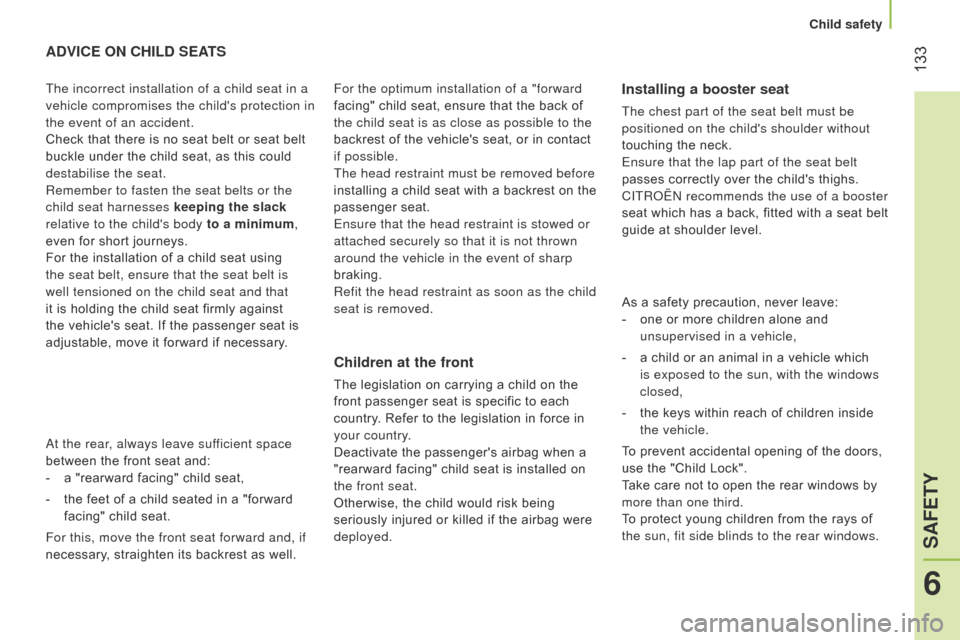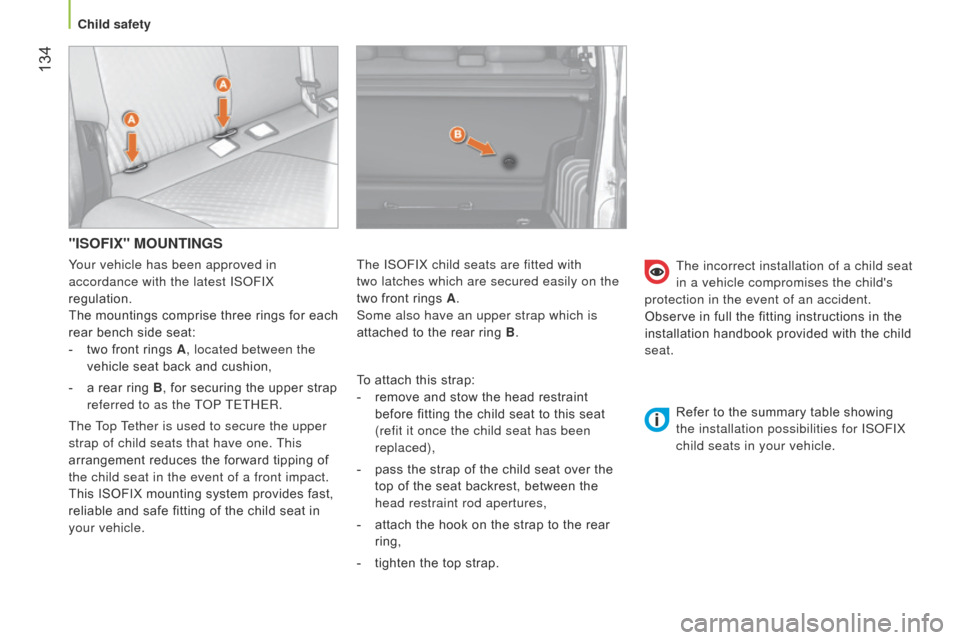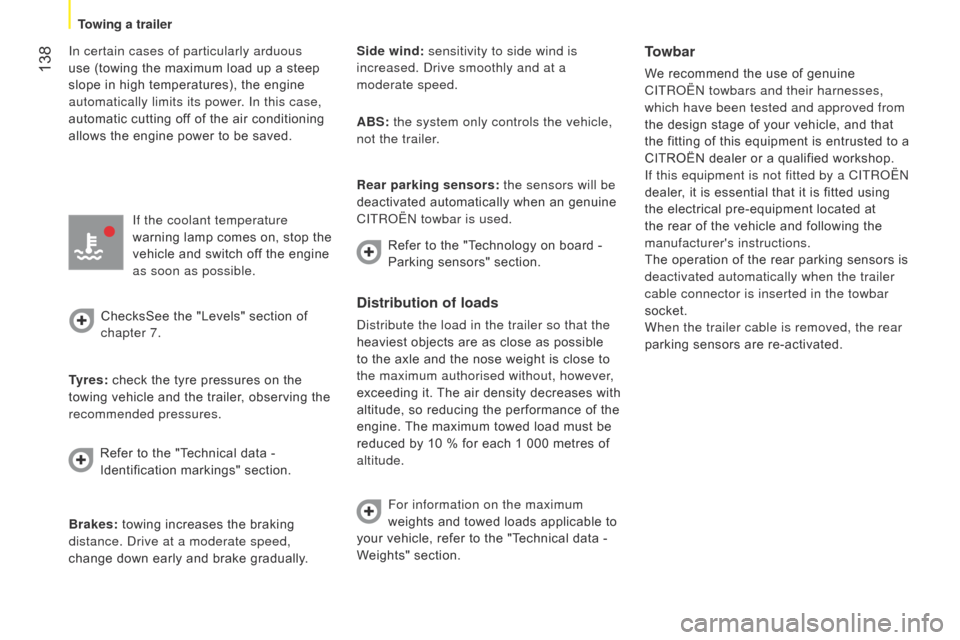Citroen NEMO 2015 1.G Owner's Manual
Manufacturer: CITROEN, Model Year: 2015, Model line: NEMO, Model: Citroen NEMO 2015 1.GPages: 192, PDF Size: 7.84 MB
Page 131 of 192

LTNIEKADA neįrenkite vaiko prilaikymo priemonės su atgal atgręžtu vaiku ant sėdynės, kuri saugoma VEIKIANČIOS priekinės ORO
PAGALVĖS. Išsiskleidus oro pagalvei vaikas gali būti MIRTINAI arba SUNKIAI TRAUMUOTAS.
LVNEKAD NEuzstādiet uz aizmuguri vērstu bērnu sēdeklīti priekšējā pasažiera sēdvietā, kurā ir AKTIVIZĒTS priekšējais DROŠĪBAS GAISA
SPILVEn S.
Tas var izraisīt BĒRNA NĀVI vai radīt NOPIETNUS IEVAINOJUMUS.
MTQatt m’ghandek thalli tifel/tifla marbut f’siggu dahru lejn l-Airbag attiva, ghaliex tista’ tikkawza korriment serju jew anke mewt lit-tifel/tifla
nLPlaats NOOIT een kinderzitje met de rug in de rijrichting op een zitplaats waarvan de AIRBAG is INGESCHAKELD. Bij het afgaan van de
airbag kan het KIND LEVENSGEVAARLIJK GEWOND RAKEN
noInstaller ALDRI et barnesete med ryggen mot kjøreretningen i et sete som er beskyttet med en frontal AKTIVERT KOLLISJONSPUTE,
BARNET risikerer å bli DREPT eller HARDT SKADET.
PLNIGDY nie instalować fotelika dziecięcego w pozycji "tyłem do kierunku jazdy" na siedzeniu wyposażonym w CZOŁOWĄ PODUSZKĘ
POWIETRZNĄ w stanie AKTYWNYM. Może to doprowadzić do ŚMIERCI DZIECKA lub spowodować u niego POWAŻNE OBRAŻENIA
CIAŁA.
PTNUNCA instale um sistema de retenção para crianças de costas para a estrada num banco protegido por um AIRBAG frontal ACTIVADO.
Esta instalação poderá provocar FERIMENTOS GRAVES ou a MORTE da CRIANÇA.
RoNu instalati NICIODATA un sistem de retinere pentru copii, dispus cu spatele in directia de mers, pe un loc din vehicul protejat cu AIRBAG
frontal a CTIVaT . a ceasta ar putea provoca M oa RTE a C o PILULUI sau R an IRE a lui GR aVa .
RUВО ВСЕХ СЛУЧАЯХ ЗАПРЕЩАЕТСЯ использовать обращенное назад детское удерживающее устройство на сиденье, защищенном
ФУНКЦИОНИРУЮЩЕЙ ПОДУШКОЙ БЕЗОПАСНОСТИ, установленной перед этим сиденьем.
Это может привести к ГИБЕЛИ РЕБЕНКА или НАНЕСЕНИЮ ЕМУ СЕРЬЕЗНЫХ ТЕЛЕСНЫХ ПОВРЕЖДЕНИЙ
SkNIKDY neinštalujte detské zádržné zariadenie orientované smerom dozadu na sedadlo chránené AKTIVOVANÝM čelným AIRBAGOM.
Mohlo by dôjsť k SMRTEĽNÉMU alebo VÁŽNEMU PORANENIU DIEŤAŤA.
SLNIKOLI ne nameščajte otroškega sedeža s hrbtom v smeri vožnje, če je VARNOSTNA BLAZINA pred sprednjim sopotnikovim sedežem
AKTIVIRANA. Takšna namestitev lahko povzroči SMRT OTROKA ali HUDE POŠKODBE.
SRNIKADA ne koristite dečje sedište koje se okreće unazad na sedištu zaštićenim AKTIVNIM VAZDUŠNIM JASTUKOM ispred njega, jer mogu
nastupiti SMRT ili OZBILJNA POVREDA DETETA.
SVPassagerarkrockkudden fram MÅSTE vara avaktiverad om en bakåtvänd bilbarnstol installeras på denna plats. Annars riskerar barnet att dÖ da S eller S kada S a LLVa RLIGT.
TRKESİNLKLE HAVA YASTIĞI AKTİF olan ön koltuğa yüzü arkaya dönük bir çocuk koltuğu yerleştirmeyiniz. Bu ÇOCUĞUN ÖLMESİNE veya
ÇOK AĞIR YARALANMASINA sebep olabilir.
129
6
SaFETY
Child safety
Page 132 of 192

130
CHILD SEATS RECOMMENDED BY CITROËN
CITROËN offers a range of recommended child seats which are secured using a three
point seat belt.Group 0+: from birth to 13 kg
L1
"RÖMER Baby-Safe Plus"
Installed in the rearward facing position.
Groups 2 and 3: from 15 to 36 kg L4
"
k LIPP
an
o ptima"
From 22 kg (approximately 6 years), the booster is used on its own.
L5
"RÖMER
k I d FIX"
Can be fitted to the vehicle's ISOFIX mountings. The child is restrained by the seat belt.
Child safety
Page 133 of 192

131
INSTALLING CHILD SEATS ATTACHED USING THE SEAT BELT (LIGHT VAN)
In accordance with European regulations, this table indicates the options for installing child seats secured using a seat belt and universally
approved in accordance with the weight of the child and the seat in the vehicle.Weight of the child and indicative age
Seat Under 13 kg
(groups 0 (a ) and 0+)
Up to approx 1 year From 9 to 18 kg
(group 1)
1 to 3 years approx From 15 to 25 kg
(group 2)
3 to 6 years approx From 22 to 36 kg
(group 3)
6 to 10 years approx
Front passenger
seat (b ) U
UUU
a : Group 0: from birth to 10 kg. Infant car seats and "car cots" cannot be installed on the front passenger seat.
b : consult the legislation in force in your country before installing your child on this seat.
U :
seat suitable for the installation of a child seat secured usin
g a seat belt and universally approved, "rearward facing" and/or "forward
facing".
6
SAFETY
Child safety
Page 134 of 192

132
INSTALLING CHILD SEATS ATTACHED USING THE SEAT BELT (COMBI)
In accordance with European regulations, this table indicates the options for installing child seats secured using a seat belt and universally
approved in accordance with the weight of the child and the seat in the vehicle.Weight of the child and indicative age
Seat Under 13 kg
(groups 0 (a ) and 0+)
Up to approx 1 year From 9 to 18 kg
(group 1)
1 to 3 years approx From 15 to 25 kg
(group 2)
3 to 6 years approx From 22 to 36 kg
(group 3)
6 to 10 years approx
Front passenger
seat (b ) U
UUU
o
uter rear seats UUUU
Centre rear seat UUUU
a : Group 0: from birth to 10 kg. Infant car seats and "car cots" cannot be installed on the front passenger seat.
b : consult the legislation in force in your country before installing your child on this seat.
U :
seat suitable for the installation of a child seat secured usin
g a seat belt and universally approved, "rearward facing" and/or "forward
facing".
Child safety
Page 135 of 192

133
ADVICE ON CHILD SEATS
Children
at the front
The legislation on carrying a child on the
front passenger seat is specific to each
country. Refer to the legislation in force in
your country.
Deactivate the passenger's airbag when a
"rearward facing" child seat is installed on
the front seat.
Otherwise, the child would risk being
seriously injured or killed if the airbag were
deployed.
The incorrect installation of a child seat in a
vehicle compromises the child's protection in
the event of an accident.
Check that there is no seat belt or seat belt
buckle under the child seat, as this could
destabilise the seat.
Remember to fasten the seat belts or the
child seat harnesses keeping the slack
relative to the child's body to a minimum,
even for short journeys.
For the installation of a child seat using
the seat belt, ensure that the seat belt is
well tensioned on the child seat and that
it is holding the child seat firmly against
the vehicle's seat. If the passenger seat is
adjustable, move it forward if necessary.
Installing a booster seat
The chest part of the seat belt must be
positioned on the child's shoulder without
touching the neck.
Ensure that the lap part of the seat belt
passes correctly over the child's thighs.
CITR
o Ë n recommends the use of a booster
seat which has a back, fitted with a seat belt
guide at shoulder level.
For the optimum installation of a "forward
facing" child seat, ensure that the back of
the child seat is as close as possible to the
backrest of the vehicle's seat, or in contact
if possible.
The head restraint must be removed before
installing a child seat with a backrest on the
passenger seat.
Ensure that the head restraint is stowed or
attached securely so that it is not thrown
around the vehicle in the event of sharp
braking.
Refit the head restraint as soon as the child
seat is removed.
As a safety precaution, never leave:
-
one or more children alone and
unsupervised in a vehicle,
-
a child or an animal in a vehicle which
is exposed to the sun, with the windows
closed,
-
the keys within reach of children inside
the vehicle.
To prevent accidental opening of the doors,
use the "Child Lock".
Take care not to open the rear windows by
more than one third.
To protect young children from the rays of
the sun, fit side blinds to the rear windows.
a
t the rear, always leave sufficient space
between the front seat and:
-
a "rearward facing" child seat,
-
the feet of a child seated in a "forward
facing" child seat.
For this, move the front seat forward and, if
necessary, straighten its backrest as well.
6
SAFETY
Child safety
Page 136 of 192

134
"ISOFIX" MOUNTINGS
To attach this strap:
-
remove and stow the head restraint
before fitting the child seat to this seat
(refit it once the child seat has been
replaced),
-
pass the strap of the child seat over the
top of the seat backrest, between the
head restraint rod apertures,
-
attach the hook on the strap to the rear
ring,
-
tighten the top strap.
Y
our vehicle has been approved in
accordance with the latest IS
o
FIX
regulation.
The mountings comprise three rings for each
rear bench side seat:
-
two front rings
A
, located between the
vehicle seat back and cushion,
-
a rear ring
B , for securing the upper strap
referred to as the T
o
P TETHER.
The Top Tether is used to secure the upper
strap of child seats that have one. This
arrangement reduces the forward tipping of
the child seat in the event of a front impact.
This ISOFIX mounting system provides fast,
reliable and safe fitting of the child seat in
your vehicle. The incorrect installation of a child seat
in a vehicle compromises the child's
protection in the event of an accident.
Observe in full the fitting instructions in the
installation handbook provided with the child
seat.
Refer to the summary table showing
the installation possibilities for IS
o FIX
child seats in your vehicle.
The IS
o FIX child seats are fitted with
two latches which are secured easily on the
two front rings A .
Some also have an upper strap which is
attached to the rear ring B .
Child safety
Page 137 of 192

135
RÖMER BabySafe Plus ISOFIX
(size category E )
Group 0+: up to 13 kg
It is installed in the rearward facing position using an ISOFIX base which attaches
to the rings A .
The support leg for the ISOFIX base must be adjusted in height so that it is contact with the floor of the vehicle.
RÖMER Duo Plus ISOFIX
(size category B1)
Group 1: from 9 to 18 kg
It is installed in the forward facing position.
It is fitted with an upper strap that is attached to the
ISOFIX upper ring,
called the T
o
P TETHER.
Three angles for the shell: sitting, inclined and lying positions.
This child seat can also be used on seats which are not fitted with ISOFIX mountings.
In this case, it must be attached to the vehicle seat using the three-point seat belt.
Follow the instructions for fitting the child seat given in the seat man\
ufacturer's installation guide.
ISOFIX CHILD SEAT RECOMMENDED BY CITROËN AND APPROVED FOR YOUR VEHICLE (C OMBI )
6
SAFETY
Child safety
Page 138 of 192

136
LOCATIONS FOR THE INSTALLATION OF ISOFIX CHILD SEATS (COMBI)
In accordance with European regulations, this table indicates the options for the installation of ISOFIX child seats on the vehicle seats fitted
with ISOFIX mountings.
In the case of the universal and semi-universal ISOFIX child seats, the child seat's ISOFIX size category, determined by a letter from A to G,
is indicated on the child seat next to the ISOFIX logo.
IUF: seat suitable for the installation of an I sofix Universal seat, "F orward facing" and secured using the "Top Tether" upper strap.
IL-SU: seat suitable for the installation an I sofix Semi-U niversal seat which is:
-
"rearward facing" fitted with a "T
op Tether" upper strap or a support leg,
-
"forward facing" fitted with a support leg,
For securing the "T
op Tether" upper strap, refer to the "Isofix Mountings" section.
X: seat which is not suitable for the installation of an ISOFIX seat of the size category indicated. Weight of the child / indicative age
Less than 10 kg (group 0)
Up to 6 months approx Less than 10 kg
(group 0)
Less than 13 kg
(group 0+)
Up to 1 year approx From 9 to 18 kg (group 1)
From 1 to 3 years approx
Type of ISOFIX child seat Infant car seat*"rearward facing" "rearward
facing" "forward facing"
ISOFIX size category F G C D E C D A B B1
Universal and semi-universal ISOFIX child
seats which can be installed on the outer
rear seats X
IL-SU IL-SU IUF
* Infant car seats and "car cots" cannot be installed on the front passenger seat.
Child safety
Page 139 of 192

137
TOWING A TRAILER, CARAVAN, ETC...
Driving advice
as the fan is electrically controlled, its
cooling capacity is not dependent on the
engine speed.
On the contrary, use a high gear to lower the
engine speed and reduce your speed. In all cases, pay attention to the coolant
temperature.
A towed vehicle must free wheel: gearbox in
neutral.
Cooling: towing a trailer on a slope
increases the coolant temperature.
7
ACCESSORIES
Towing a trailer
Page 140 of 192

138
In certain cases of particularly arduous
use (towing the maximum load up a steep
slope in high temperatures), the engine
automatically limits its power. In this case,
automatic cutting off of the air conditioning
allows the engine power to be saved.If the coolant temperature
warning lamp comes on, stop the
vehicle and switch off the engine
as soon as possible.
ChecksSee the "Levels" section of
chapter 7.
Tyres: check the tyre pressures on the
towing vehicle and the trailer, observing the
recommended pressures.
Brakes: towing increases the braking
distance.
d rive at a moderate speed,
change down early and brake gradually. Side wind: sensitivity to side wind is
increased.
d rive smoothly and at a
moderate speed.
ABS: the system only controls the vehicle,
not the trailer.
Distribution of loads
distribute the load in the trailer so that the
heaviest objects are as close as possible
to the axle and the nose weight is close to
the maximum authorised without, however,
exceeding it. The air density decreases with
altitude, so reducing the performance of the
engine. The maximum towed load must be
reduced by 10 % for each 1 000 metres of
altitude.
Refer to the "Technical data -
Identification markings" section. Rear parking sensors: the sensors will be
deactivated automatically when an genuine
CITR
o Ë n towbar is used.
Towbar
We recommend the use of genuine
CITR
o Ë n towbars and their harnesses,
which have been tested and approved from
the design stage of your vehicle, and that
the fitting of this equipment is entrusted to a
CITROËN dealer or a qualified workshop.
If this equipment is not fitted by a CITR
o Ë n
dealer
, it is essential that it is fitted using
the electrical pre-equipment located at
the rear of the vehicle and following the
manufacturer's instructions.
The operation of the rear parking sensors is
deactivated automatically when the trailer
cable connector is inserted in the towbar
socket.
When the trailer cable is removed, the rear
parking sensors are re-activated.
Refer to the "Technology on board -
Parking sensors" section.
For information on the maximum
weights and towed loads applicable to
your vehicle, refer to the "Technical data -
Weights" section.
Towing a trailer